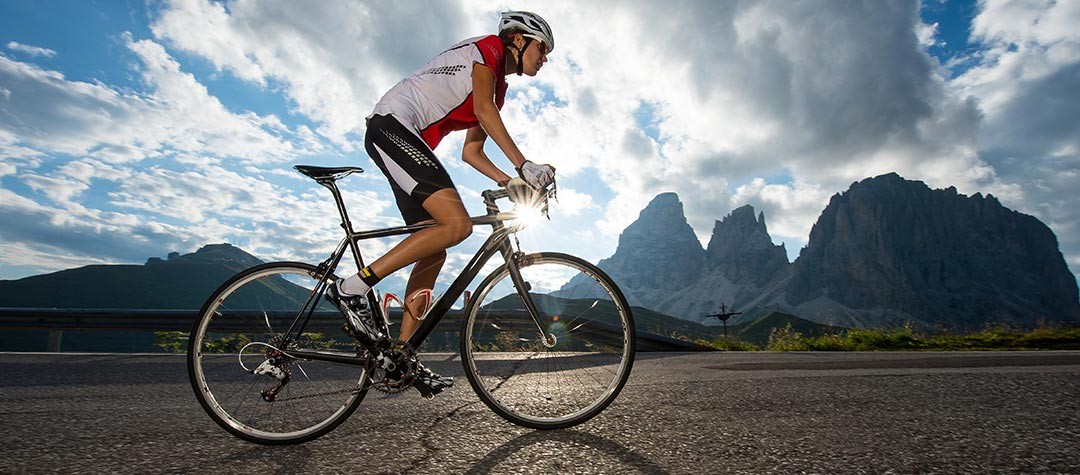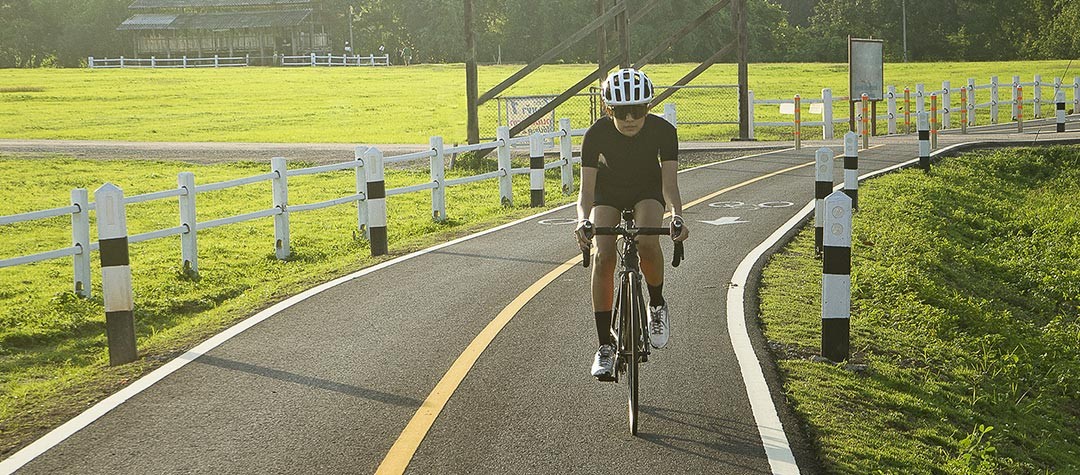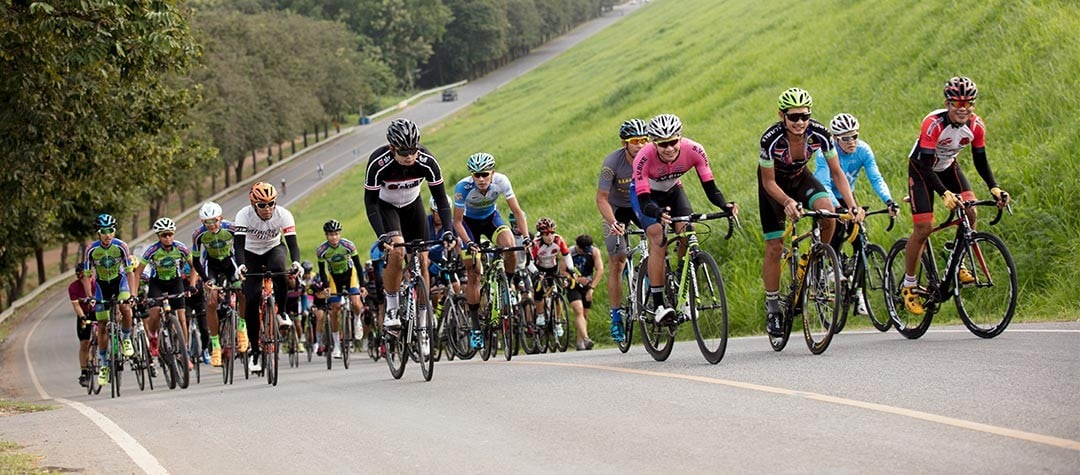Find out about the most common injury issues for cyclists and learn how to prevent them.
Hours on the bike can take their toll on the body, and riding does not come without risk, especially if you struggle to stay upright! Incorrect bike set up, poor riding position, lack of flexibility, and the potential for accidents all mean that you are at risk of injury. Here are some of the most common injury problems experienced by cyclists and how you can hopefully prevent them.
Knee pain
The repetitive nature of cycling puts the knee at risk from overuse injuries. Commonly beginners may stress the knee joints by trying to do too much too soon and by pedalling in too high a gear for too long.
In addition, a number of other factors including incorrect saddle height, the wrong sized bike, and insecure or wrongly positioned shoe cleats can all contribute towards placing additional stress on the knees.
Solution:
- Have a proper bike fit so that your bike is set up correctly, including saddle height and cleat position. Ideally the saddle height should be set to allow a slight knee bend when the pedal reaches the very bottom of a revolution.
- Ensure your cleats are always tightened as they can sometimes loosen and shift around. By drawing around the cleat with a permanent marker you’ll be able to see the position they should always be in. Shoe implants and wedges beneath the shoes may also help with some knee issues.
- Switch to lower gears whenever appropriate to avoid stressing the knee joints.
- If experiencing knee pain the reduce the amount of hill work and hard training and consult a professional if the pain persists.
Iliotibial band (ITB) Syndrome
The ITB, which runs from the hip to the outside of the knee, is commonly an injury affected area among cyclists. After a long ride, cyclists may experience pain and tenderness across the outer part of the thigh and also knee. ITB Syndrome is a common injury for both cyclists and runners and can affect both new and seasoned cyclists.
There are many factors which can contribute towards ITB syndrome. Sometimes it is just due to overuse, and in other cases it can be due to muscle imbalance, where some muscle groups have become too tight, while others have become too weak or fatigued. Muscle imbalances can be exaggerated by incorrect bike set up.
Solutions:
- Correct bike set up including saddle height and angle of seat. If the seat is too high then the knee over straightens, if it’s too low then the knee over bends.
- Cleats positioned correctly to prevent excessive inward rotation of the knee joint. It is advisable to avoid feet pointing inwards when cycling as this increases stress through the ITB.
- Fixing leg length discrepancies with wedges or customised shoe orthotics.
- Recovery stretches and strengthening exercises for often weaker muscles such as the hip flexors.
- Foam rolling of the ITB helps to release troublesome knots and gently stretches the ITB.
Lower back pain
Cycling is not one of the most natural of positions you can put your body in, often for hours at time. The bent-over style of a road bike does put strain on the lower back, and moreso if its a time trial bike aiming to get an even more aerodynamic but increasingly comfortable position.
Cyclists usually develop strong leg muscles, but don’t always have the core strength to resist the growing force from the legs. This means the back can be forced to work too hard, leading to pain on a ride which gets progressively worse during the duration of a ride.
Solution:
- Choose a bike with a more relaxed geometry so that you are in a more relaxed less aggressive riding position.
- Again, the correctly sized and set up of the bike will avoid you having to overreach (if the bike is too large) or being hunched (if the bike is too small). Raising the bars slightly may make for a more comfortable ride.
- Take the opportunity to change position on the bike when riding, such as riding out of the seat for a duration, to ease the strain on the back.
- Work on developing your core and improving flexibility in all key muscles, notably the hamstrings which are known to contribute to lower back issues.
- Do a warm down after a ride and include some stretches specifically targetting the back to minimise post-ride soreness and increased flexibility.
Shoulder/neck pain
Pain across the shoulders and neck is not uncommon, especially when riding in one position for too long. Some pain when you first start out riding as beginner is normal as the body gets more accustomed to riding in this position.
If the pain persists or becomes unbearable that it greatly impacts on your ability to enjoy a ride then you need to consider making adjustments to your bike set up and how you ride.
Pain in the shoulders occurs during longer rides and is mainly caused by placing too much weight on the hands, and riding with straight elbows.
To prevent or remedy shoulder pain, keep the elbows slightly flexed to stop ‘road shock’ transferring to the arms and upper body.
Solution:
- When riding, change your grip position on the handlebars, moving them from the drops to the tops and inbetween in order to reduce the stress on over-used muscles.
- During a ride and after you can do some shoulder shrugs and neck stretches to help relieve tension.
- Try adjusting the height of the handlebars to ease the pressure on the neck. If the handlebars are too low, cyclists will often have to round their backs, thus putting additional strain on the neck.
- Tight hamstrings and/or hip flexor muscles can also cause cyclists to round or arch their back, so stretch these muscles in order to maintain proper form and avoid undue pressure on the neck.
- To prevent shoulder pain, keep the elbows slightly bent, not locked straight, as bent elbows will act as natural shock absorbers from road vibrations.
Foot numbness and tingling
Foot numbness and tingling will have been experienced by all riders at some point. Ill-fitting shoes, shoe straps being pulled too tight, road vibration and sustained pressure on the feet (often through lots of climbing) all contribute to the strange foot tingling sensations. Essentially, the tingling or numbness is caused by nerves being squashed. Often is a case of trial and error to find the right shoes for you and the correct tension to do the straps up.
Solution:
- Ensure you get correctly fitting shoes and bear in mind that some shoes are also sold in a variety of widths as well as sizes, which do vary from manufacturer to manufacturer.
- Adjust your shoes, or the straps and even consider thinner socks if they are causing the shoes to be rather too tight.
Hand tingling and numbness
A tingling sensation and numbness in the hands can often be felt by riders, especially on long rides. How you grip the handlebars and the position of your wrists can have a major bearing on your comfort, while vibration from the road can also be a factor.
Solution:
- Check how firmly you grip the handlebars as a tight grip could be causing the issue. Your grip on the bars should be firm yet relaxed with your wrist kept straight and not bent.
- Change hand positions frequently to help minimise discomfort.
- Use padded gloves and decent padded handlebar tape to reduce the vibration.
- Keep your elbows slightly bent to stop minimise vibration transferring from the road to the arms and along to the hands.
Road rash
If you’ve ever took a tumble off your bike then you’ve probably experienced ‘road roash’, that graze the comes from contact with the road surface. Alone, it won’t usually be enough to stop you completing your ride, but it’s afterwards when you’ll often start to feel it.
Solution:
- I t may seem like stating the obvious, but try and stay on your bike and don’t come off!
- Wearing lycra and gloves can offer some degree of protection, but in the case of lycra is certainly limited
- If you sustain a serious graze then be sure to clean the wound and ensure any muck and loose debris is out and cover it with a dressing. Monitor, clean and redress daily.
Saddle sores
Hours on the bike can take their toll, but in particular on the part of the body in contact with your saddle. The ‘sit bones’ and the perineum (the area between your anus and genitals), are the areas most prone to soreness.
The main reason for soreness is pressure, whereby bodyweight is focused on a small area which reduces blood flow to that area meaning that the skin doesn’t get the oxygen and nutrients it needs. In some instances, riders (more commonly women) can suffer from chafing on their inner thighs caused by rubbing on the saddle during the pedalling motion.
Solution:
- Build up gradually and don’t just jump into doing a long ride - your body needs time to adapt.
- Get out of the saddle occasionally when riding in order to restore some blood flow to your affected areas.
- Get the right saddle for you. Remeber what is right for someone else may not be suitable for you.
- Buy good quality cycling shorts and chamois cream to reduce friction.
Head injuries
Perhaps the most important one of all to consider is head injuries. This could be anything from a cut on the forehead to a traumatic brain injury, but the consequences of serious head injury can be catastrophic. Despite the debate about wearing helmets, or even making them compulsory, there really isn’t a good reason not to wear one.
Solution:
- Wear a helmet. The wearing of a helmet may reduce the risk for head injury by as much as 85 per cent.
- Make sure your helmet is a good fit and properly secured as you don’t want it to be slipping around every time you move your head or, even worse, come off or hit an obstacle head on.














